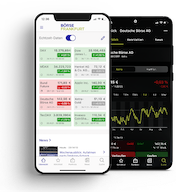Bonds: A tense look at Donald Trump's first measures

The rise in US yields was slowed in the second half of the week. The decline in core inflation in the US is fueling hopes of interest rate cuts. But experts remain cautious: political decisions could quickly change direction again.
17 January 2025 FRANKFURT (Frankfurt Stock Exchange). The rise in yields on the bond markets initially continued at the start of the current week. Ten-year US Treasuries climbed to a high of around 4.80 %. This means that yields have risen by more than one percentage point within three months. However, the tide turned in the middle of the week and yields fell sharply to below 4.60 %. This was due to market reactions to the inflation data in the USA.
Hope for an interest rate cut soon
"The US consumer price data for December has taken the wind out of the sails of the bond bears for the time being," say the analysts at LBBW. In particular, the surprising decline in the Fed's CPI rate (excluding energy and food) from 3.3 to 3.2 percent, which is particularly noteworthy, has fueled hopes for further easing by the Fed. "Market participants are currently speculating in the direction of another rate cut," explains bond trader Klaus Stopp of Baader Bank. However, this could quickly change again depending on the data. The LBBW experts consider a rate cut in the current quarter to be "unlikely," which is why the prospects for a longer-term rally in the US Treasury market (falling yields) are also "rather muted.
What will the new US president do?
In the coming week, stock market participants will be keeping a close eye on Donald Trump's inauguration on Monday. According to Helaba strategists, whether there will be a significant easing on the bond markets depends on the decisions made by the new US president. “If he fuels inflation expectations or worries about a further increase in government debt, investor sentiment is likely to quickly deteriorate again.” Our colleagues at LBBW take the same view, but have another scenario on their radar: “If Trump actually implements his tariff plans with less force than he threatened during the election campaign, this could dampen investors' concerns about inflation once again”.
A useful look at the chart
From a chart technical perspective, the ten-year US yield failed this week at its long-term resistance level of 4.74%, as Marcel Mußler analyzes. Although the subsequent “counter-rally” will “not remain a one-way street”, the development shows “that Wednesday's inflation day was not a flash in the pan”. However, there are currently no signs of a medium-term trend reversal. For this to happen, the “still very broad medium-term upward trend” at 4.36% would have to be broken on a sustained basis. However, a drop below a previous high of 4.643% would at least make a test of the “major support” at 4.52% conceivable. The LBBW specialists are also keeping an eye on this level. “Bearish exaggeration tendencies, which arose 'under the spell of the 5 percent mark', could now be corrected, which in our opinion could push the 10-year US benchmark yield down towards 4.50 percent”
“Investments to diversify the bond portfolio”
According to Stopp, there is “strong interest from small investors” in German bonds in the corporate bond segment, particularly at the longer term. Bonds from Porsche (XS2802892054), E.On (XS2791960664), MTU (XS2887896574), Lufthansa (XS2892988192), Fraport (XS2832873355) and Deutsche Post (XS2784415718), each offered in 1,000 denominations, are being purchased. The securities currently yield between 3.3% and 4.0% with maturities of six years or more. Stopp refers to these as “classic investments to diversify bond holdings”.
By Thomas Koch, 17 January 2025, © Deutsche Börse
About the Author
Thomas Koch is a CEFA investment analyst, investment specialist for structured products and a certified certificate consultant. He has been a freelance journalist covering events on the capital markets since the beginning of 2006.
Feedback and questions to redaktion@deutsche-boerse.com





